-
 2932 Hits
2932 Hits
-
 80.49% Score
80.49% Score
-
 12 Votes
12 Votes
|
|
Area/Range |
|---|---|
|
|
45.65560°N / 7.37768°E |
|
|
Hiking, Mountaineering, Trad Climbing |
|
|
Spring, Summer, Fall, Winter |
|
|
11355 ft / 3461 m |
|
|
Note
La montagna chiama i suoi figli, ed essi rispondono fedelmente al suo appello… Osvaldo Cardellina, Diario alpinistico, 1964-65 Page texts: @ OsvaldoCardellina "Osva", passed away on May 2, 2022. Page owners: Christian Cardellina e Osvaldo Cardellina. Any updates from September 12, 2022: Antonio Giani, page administrator, friend and climbing companion. Testi della pagina: @ OsvaldoCardellina "Osva", scomparso il 2 maggio 2022. Proprietari pagina: Christian Cardellina e Osvaldo Cardellina. Eventuali aggiornamenti dal 12 settembre 2022: Antonio Giani, amministratore della pagina, amico e compagno di salite. |
Overview
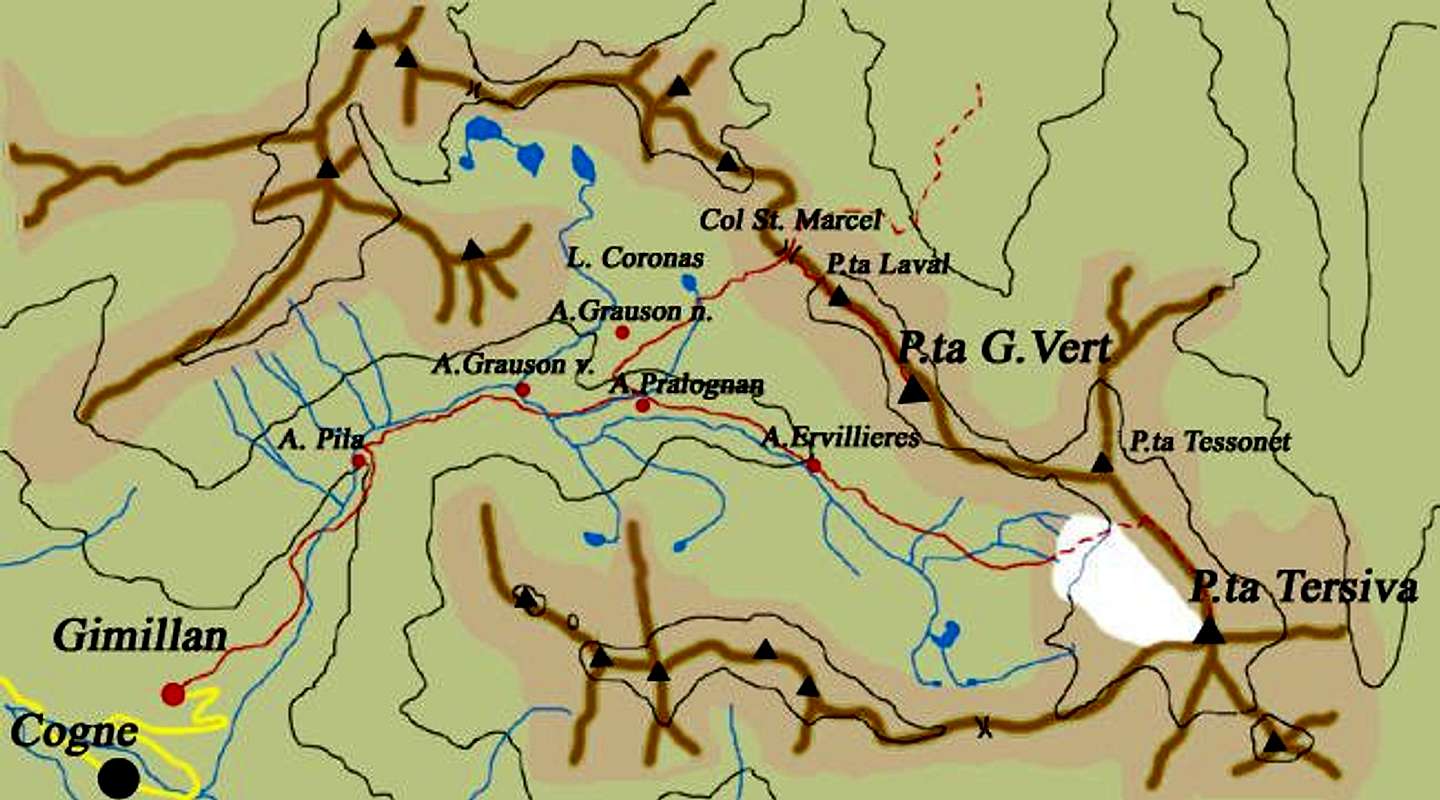
Great, Gru, Grand or Grauson? Actually this valley, which opens immediately behind the old Village Gimillan (around 1.785m) above the Common of Cogne, derives its name from the characteristic of being as long as it extended. Place on the axis South / North, after an initial part represented by the erosion of Stream Gru, which takes its name, for this reason, the meeting of Torrents de Lussert, Corona and Doreire, spreads like a big leaf in which You can distinguish three specific areas. Starting from the West, or from the slopes of the important summits arranged in a radial pattern with Mont also Tour Grauson (3.240m), Punta or Pic Garin, the highest of all this Western area of Grauson), Red Points of Emilius (3.401m), Punta di Laures (3.367m), Mont des Laures, Lussert and Punta di Leppe (3.305m); from this last it goes down the partition with the Valley of Saint Marcel forming the Col Vallonet, the Mont Vallonet (3.098m), the important Colle di Saint Marcel also known as Col Coronas (2.916m), the two Punte di Laval and the Punta Gianni Vert (3.148m). Finally, one last stretch, gradually bending towards Southeast, leads, after passing over the Colle Tessonet, the homonymous peak and the Costa del Tessonet, to the great pyramid of the Tersiva (3.515m), the highest mountain in the whole Grauson area. From this the Southern watershed separates from the adjacent Vallone dell'Urtier, also in the Valle di Cogne. After the important Pass of Invergneux or d'Hevergnes (2.905m), the border crest overcomes several summits, the most prominent of which is the Mont Penne Blanche (3.254m); a final stretch reaches at first Mount Creya (3.015m) and finally, definitely at Mezzogiorno, the Mont Salet or Monsalé also Montsalet (2.759 meters, area of the collocation of the magnetite mines near Cogne Municipality). Of all the three sectors analyzed, a homogeneous analysis can be made regarding the activities to be performed in each of them; it can be said that in all three there are different excursion possibilities, generally related to the altitude as well as to the morphology of the territory. In general, the choices can be divided into three precise bands.

Going up to Lussert's Lochs with the Grivola in background, by Antonio We look carefully at the same:
A) - the first territory band is to be considered as aimed at novice hikers (E) and can reach the lakes at an average altitude of about 2.600/2.800 meters: so it is also of fishermen's relevance (Lussert's Lower and Middle Lakes and ajiacent Corona's Loch).
B) - The second one can be an objective for experienced hikers (EE), as well as well trained and know the morphology of the territory, as it requires a commitment that can go from five (Col des Laures Saint Marcel or Coronas Hill, Tessonet's Collar, Tersiva small Collar and Pas d'Invergneux) to the seven/eight hours (Colletto del Grauson, Pas du Valaisan).
C) - The third, more mountaineering, must be divided into two parts:
1) easy ascents (F, F+) and modest engagement without taking into account distance and hourly employment (Northern Slope and Northwest Ridge of Pic Garin, Mont Valaisan, Western Punta Rossa of Emilius, Mont des Laures, Punta Lussert and Punta di Leppe by the Standard Via);
2) challenging (from PD to D+) and sometimes dangerous climbs (North Wall of the Grauson Tour, South Face of the Punta Rossa to the various summits, Southwestern Face and South Spur of the Punta des Laures and Northeast Wall and North-northeast Edge of the Punta Garin).
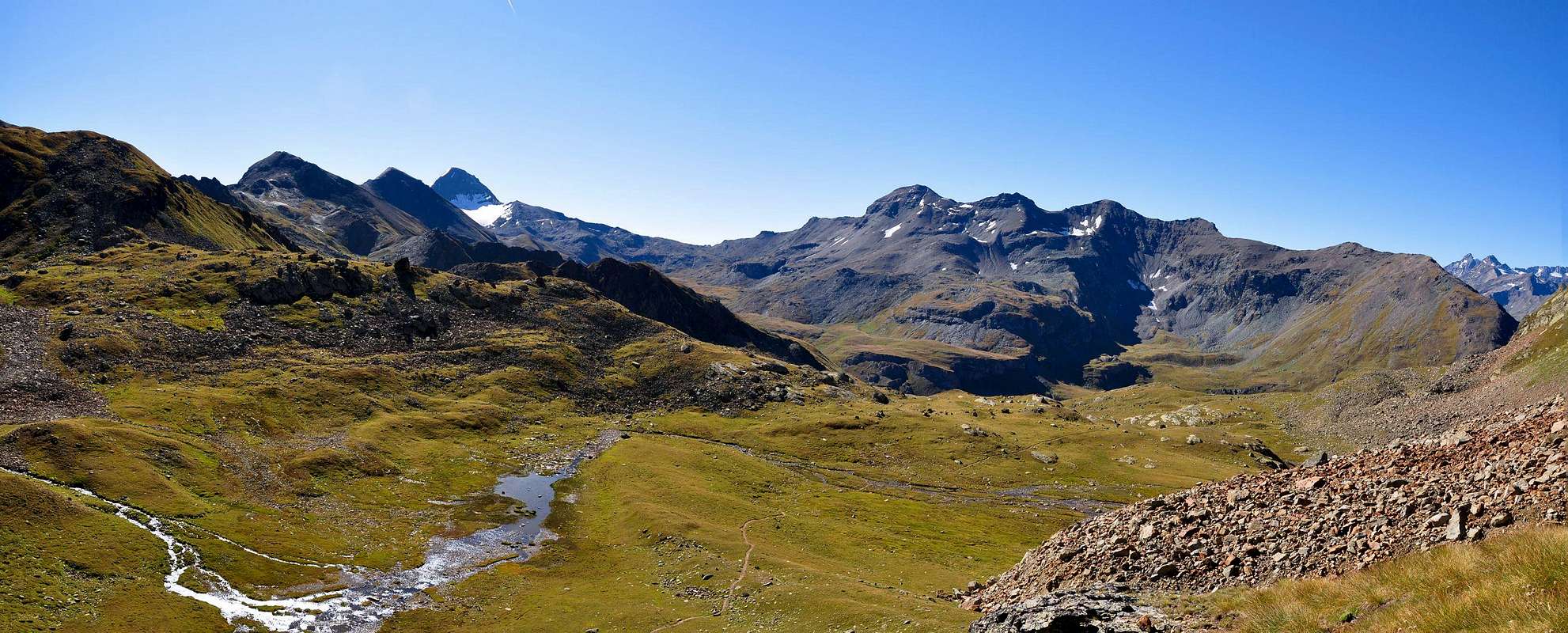
These in short the three sectors of the Vallone del Grauson:
1) - the area of the Lakes Lussert that flexing in Northwest reaches the Pas du Valaisan (to the West) and Col des Laures (to the North). This more Western side of the Grauson Valley begins at the Lower Lake of Lussert, between the grim pyramid of the Grauson Tour at Mezzogiorno and the Punta di Lussert (3.221m) in the North. Going up the same you meet the other three lakes of the same name, located on the slopes of a circle of reddish mountains that from the Grauson's Tower reach in succession the Punta Garin, Mont Valaisan with the homonymous Pass (3.210m), the three Red Points of the Emilius, the Punta di Laures with the homonyms Colle and Mont. From this last the partition with the Vallone delle Laures (Grand Brissogne Municipality) returns to the East reaching the Tip of Lussert and that of Leppe, now bordering the Valley of Saint Marcel.
2) - the central zone (here shown in the first of the photos) that reaches the Punta di Leppe (to the Northeast) and the Hill of St. Marcel (to the East). This area acts as a trait d'union between the area of the four Lakes of Lussert and the furthest Vallone di Tessonet-Doreire which leads to the foot of the homonymous glacier and Punta Tersiva. in practice it originates from the first of the Lakes of Lussert or Inferiore also Lower (2.713/21m) to end with the Colle di Saint Marcel or Corona's, an important transit point between Cogne and the Central Valley of the Dora Baltea. It bears the name of Giuseppe Corona, who crossed it first in the winter of the end of the XIXth Century (see "Guidebook of Monte Emilius 1978", page 183) .Through it is still carried out today a procession which, starting from Cogne, reaches the Sanctuary of Plou or Plout (958m) above Saint Marcel and dedicated at the "Vierge de tous pouvoirs", but which was originally dedicated to "Notre Dame des Hermites".
3) - branching to the right or Eastward to Punta Tersiva (to the East-southeast) and Pass Invergneux (to the Southeast). A sector, this one, which contains the Southern partition located between the Vallone di Grauson/Tessonet-Doreire and the Urtier's small Valley, immediately located in the East of the Fraction or Hamlet of Lillaz. In this stretch the two summits of Penne Blanche (Eastern 3.254m and more Western 3.205m) emerge and descends down as far as towards Monte Creya (3.015m). However, this sector is completely independent and moves Eastwards from the Lakes area of Lussert and, more to the East, "delle Rane" ("Loch of the Froggs"") and Corona or Corona's reaching those ones of Doreire. Treated already in a previous page, it originates from the junction that precedes Pralognan's Alp ((2.416m); see under the yellow sign). These are four in number, located at the foot of the Tessonet-Doreire Glacier and the Punta Tersiva just as far as the Hevergnes Pass or Hevergnes's Col (Winter Hill). The same overlooks the homonymous mountain pasture (2.524m), which in the past was inhabited throughout the year.
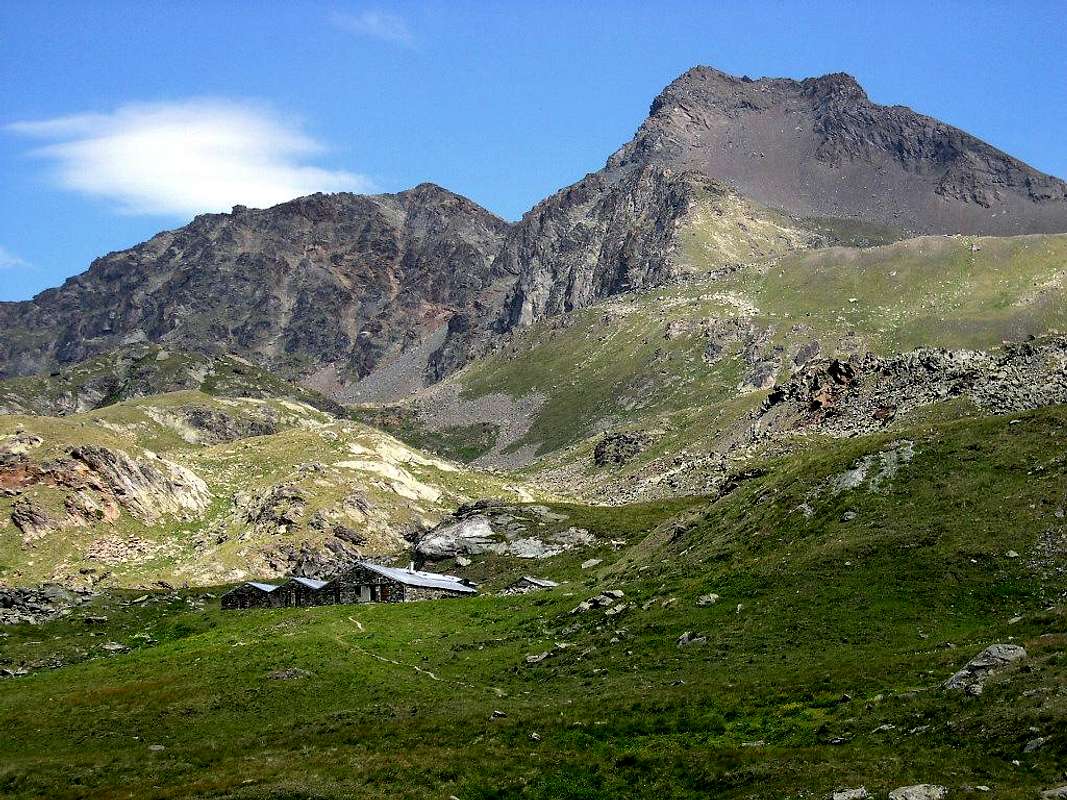
Grande, Grosso, Gru o Grauson? In realtà questo vallone, che si apre subito alle spalle del Villaggio di Gimillan (1.787 m) sopra l'abitato di Cogne, deriva il suo nome dalla caratteristica d'esser tanto lungo quanto esteso in due diverse direzioni (Nordovest ed Est-nordest). Posto sull'asse Sud/Nord, dopo una parte iniziale rappresentata dall'erosione del Torrent Gru, che, proprio per questo motivo, prende il suo nome dalla riunione dei Torrents de Lussert, Corona e Doreire, si allarga a guisa di grande foglia nella quale si posson distinguere tre precisi settori. Partendo da Ovest, ovvero dalle pendici delle importanti sommità disposte a raggiera con Tour Grauson, Punta o Pic Garin (la più elevata con 3.461 metri di tutta questa area Occidentale del Grauson), Punte Rossa dell'Emilius (3.401 m), Punta di Laures (3.367 m) , Mont des Laures, Punta di Lussert (3.221 m); Punta di Leppe (3.305 m); da questa ultima scende il divisorio con la Valle di Saint Marcel formando il Col Vallonet, il Mont Vallonet, l'importante Colle di Saint Marcel conosciuto anche come Col Coronas (2.916 m), le due Punte di Laval e la Punta Gianni Vert. Infine un ultimo tratto, piegando gradualmente più verso Sudest conduce, dopo aver scavalcato il Colle Tessonet (tra il Vallone di Grauson e St. Marcel), l'omonima punta e la Costa del Tessonet, alla grande piramide della Tersiva (3.515 m), la montagna più alta di tutto il comprensorio del Grauson. Da questa lo spartiacque Meridionale separa dall'attiguo Vallone dell'Urtier, sempre nella Valle di Cogne. Dopo l'importante Passo d'Invergneux (2.905 m), la cresta di confine supera diverse sommità la più in evidenza delle quali é il Mont Penne Blanche con le sue due sommità (Est 3.254 m, Ovest 3.205 m); un ultimo tratto raggiunge dapprima il Monte Creya (3.015 m) ed infine, decisamente a Mezzogiorno, il Mont Salet o Monsalé anche Monsalet (2.759 m, zona della collocazione delle miniere di magnetite con i vari filoni presso Cogne). Di tutti i tre settori analizzati si può effettuare un'analisi omogenea riguardo alle attività da svolgere in ognuno di essi; si può affermare che in tutti e tre si evidenziano differenti possibilità di escursione in genere correlate con l'altitudine oltre a che alla morfologia del territorio. In genere si possono suddividere le scelte in tre fasce.

Vediamo attentamente le stesse:
A) - la prima fascia territoriale é da considerare come rivolta agli escursionisti debuttanti (E), o coloro che non godono di un eccessivo allenamento, e può raggiungere i laghi ad una quota media di circa 2.600/2800 metri: quindi é anche di pertinenza dei pescatori (Laghi Inferiore e Medio di Lussert ed adiacente verso Oriente Lago Corona).
B) - La seconda invece può costituire obiettivo per escursionisti esperti (EE), nonché bene allenati e conoscenti la morfologia del territorio, poiché richiede un impegno che può andare dalle cinque (Colli des Laures, di Saint Marcel o Coronas, Colletto del Tessonet, Colletto della Tersiva e Pas d'Invergneux) alle sette/otto ore (Colletto del Grauson, Pas du Valaisan).
C) - La terza, più alpinistica, deve essere divisa a sua volta in due parti:
b1) - ascensioni facili e di modesto impegno (F, F+) senza tenere conto della distanza e dell'impiego orario (Versante Nord e Cresta Nordovest del Pic Garin, Mont Valaisan, Punta Rossa Occidentale dello Emilius, Mont des Laures, Punta di Lussert e Punta di Leppe per la Via Normale);
2) - ascensioni impegnative (da PD a D+) ed a volte anche pericolose (Parete Nord della Tour Grauson, Parete Sud della Punta Rossa verso le tre principali sommità, Sperone Sud e Faccia Sudovest della Punta des Laures e Parete Nordest nonché Spigolo Nord-nordest della Garin).
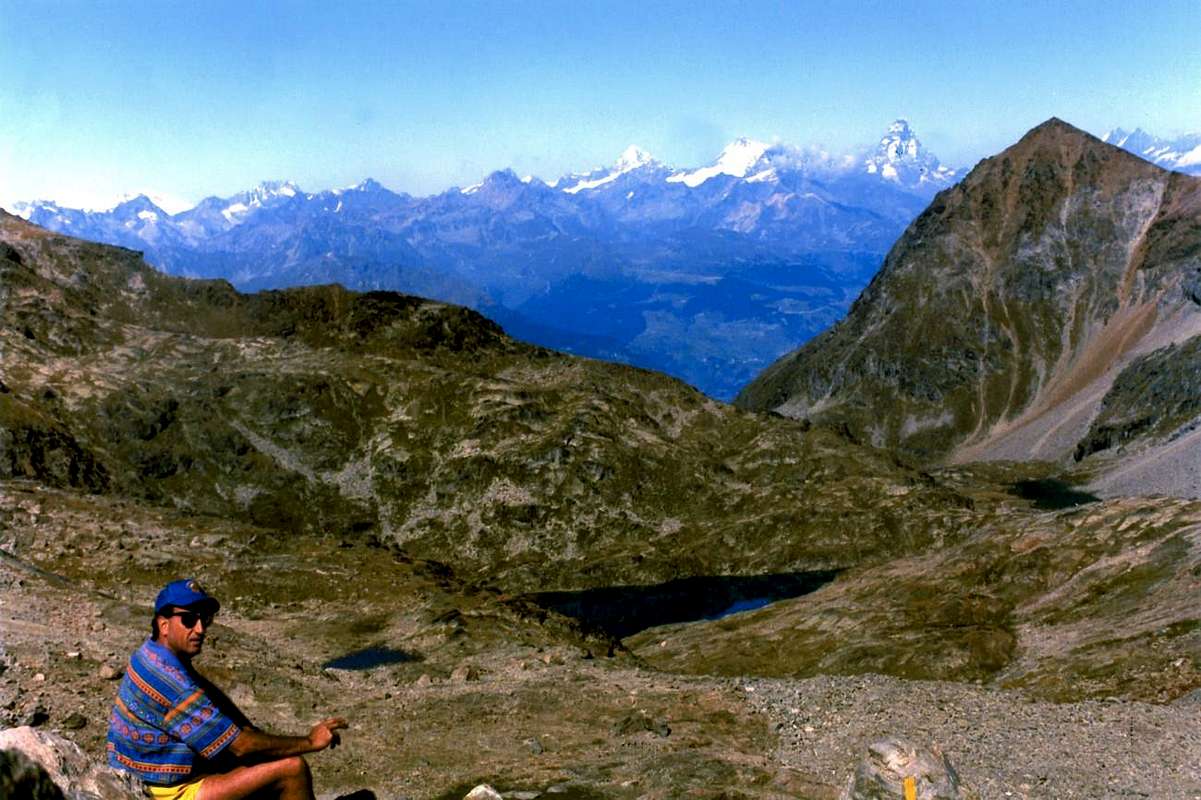
Questi in sintesi i tre settori del Vallone del Grauson:
1) - il settore dei Laghi di Lussert che flettendo a Nordovest raggiunge il Pas du Valaisan (verso Ovest) ed il Col des Laures (in direzione Nord). Questo lato più Occidentale del Vallone del Grauson prende inizio dal Lago Inferiore di Lussert, compreso tra l'arcigna piramide della Tour Grauson a Mezzogiorno e della Punta di Lussert (3.221 m) a Settentrione. Risalendo il medesimo s'incontrano gli altri tre laghi omonimi, posizionati alle pendici di una cerchia di rossicce montagne che dalla Tour Grauson raggiungono in successione la Punta Garin, il Mont Valaisan con l'omonimo Passo (3.210 m), le tre Punte Rosse dell'Emilius, la Punta di Laures con gli omonimi Colle e Mont. Da questo ultimo il divisorio con il Vallone delle Laures (Comune di Grand Brissogne) ritorna verso Oriente raggiungendo la Punta di Lussert e quella di Leppe, ormai al confine con la Valle di Saint Marcel.
2) - la zona centrale (qui evidenziato dalla pima delle foto) che raggiunge la Punta di Leppe (a Nordest) ed il Colle di St. Marcel (decisamente ad Oriente). Questa area funge da trait d'union tra la zona dei quattro Laghi di Lussert ed il più lontano Vallone di Tessonet-Doreire che conduce ai piedi dell'omonimo ghiacciaio e della Punta Tersiva. in pratica si origina dal primo dei Laghi di Lussert od Inferiore (2.713/21 m) per terminare con il Colle di Saint Marcel o Coronas, importante punto di transito tra Cogne e la Valle Centrale della Dora Baltea. Porta il nome di Giuseppe Corona che lo attraversò per primo in un inverno della fine del XiX° Secolo (vedi "Guida del Monte Emilius 1978, pag. 183) . Attraverso lo stesso si effettua ancora oggigiorno una Processione che, partendo da Cogne, raggiunge il Santuario di Plou o Plout (958 m) al di sopra di Saint Marcel e decicato alla "Vierge de tous pouvoirs", ma che in origine era dedicato a "Notre Dame des Hermites".

3) - la ramificazione verso destra od Orientale verso la Punta Tersiva (all'estremo Est-sudest) ed il Pas d'Invergneux (più verso Sudest). Un settore, questo, che contiene il divisorio Meridionale posizionato tra il Vallone di Grauson/Tessonet-Doreire ed il Vallone dell'Urtier, collocato subito ad Oriente della Frazione di Lillaz. In questo tratto emergono le due sommità del Penne Blanche (Orientale 3.254 m e maggiormente Occidentale 3.205 m). Questo settore é però completamente indipendente e si allontana verso Est dalla zona dei Laghi di Lussert e "delle Rane" e Corona. Trattato già in una precedente pagina, esso si origina dal bivio che precede l'Alpe di Pralognan (2.416 m; vedi sotto cartello giallo), raggiungendo il successivo nonché ultimo dell'Ervillières. Zona, quest'ultima, invece caratterizzata dalla presenza dei quattri Laghi Doreire, che si dispiegano ai piedi del Ghiacciaio di Tessonet-Doreire e della Punta Tersiva fino al Pas d'Invergneux oppure Col des Hevergnes' ("Colle d'Inverno o degli Inverni"). Lo stesso sovrasta l'omonimo alpeggio (2.524 m), che nei tempi passati era abitato per tutto l'anno.
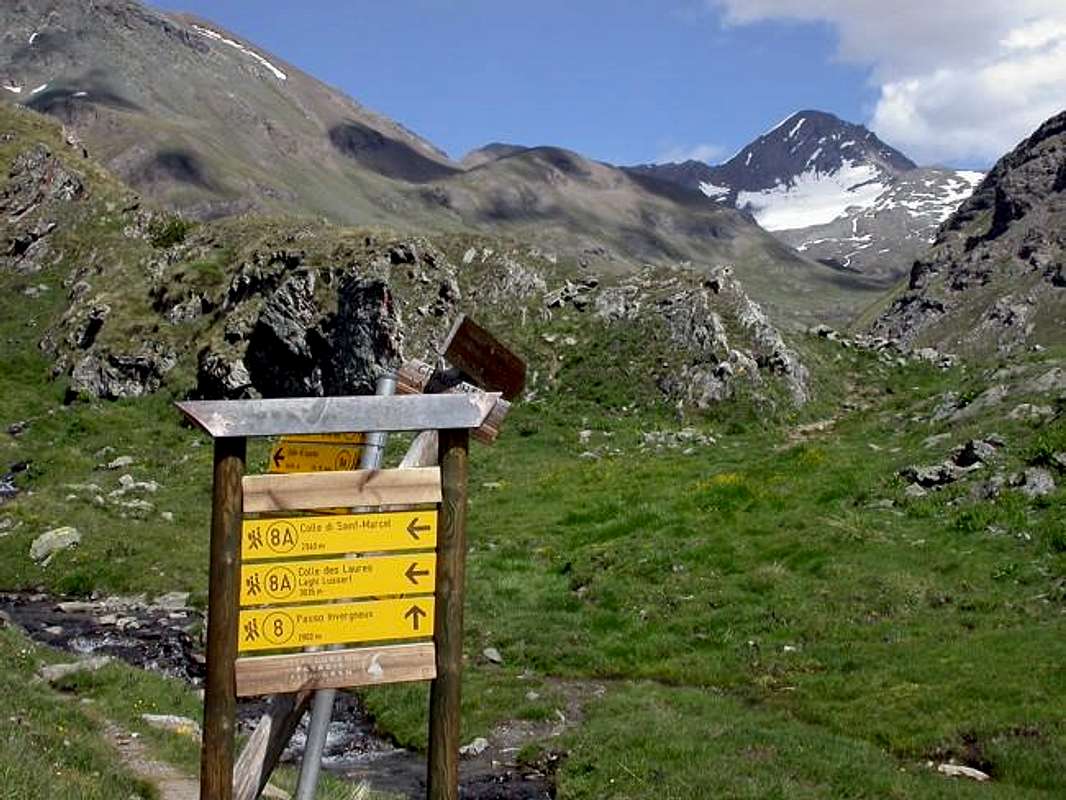
In this precise point (around 2400m), before Pralognan Pasture, the valley divides itself into two major parts: to the right or East towards Doreire-Tessonet Vallon, with Tersiva (3515m) in foreground; to the left or North-northwest Lussert's Basin
Getting There from Cogne to Gimillian Hamlet at the beginning of Grauson's Valley
- From TORINO, MILANO, etc: Motorway A5. Exit at IVREA or Quincinetto (PIEDMONT) AOSTA West/Aymavilles, Cogne Municipalities. From Aymavilles (646m) towards Cogne Valley: reacging Vieyes (1.132m), Epinel, Crétaz Hamlets to Cogne (1.534m); through Main Road. From this by Regional Road towards Montroz and Gimillan (1.785m) Villages; from the last towards the above Grauson Vallon.
- From FRANCE: through the Mont Blanc Tunnel to Entrèves-crossroads to Vény/Ferret Valleys - Mountain Guides of Courmayeur - La Saxe Rock Gym - Courmayeur. By Little Saint Bernard Hill, closed since November until half May to La Thuile Valley - Pré Saint Didier - Courmayeur.
It is not necessary to take Motorway A5: you can drive on SS.26, in the direction of AOSTA - IVREA - TURIN.
- Aeroporto "Corrado Gex" Saint Christophe (Aosta).
Seven Hikes Excursions & Climbings into the Lussert's Basin
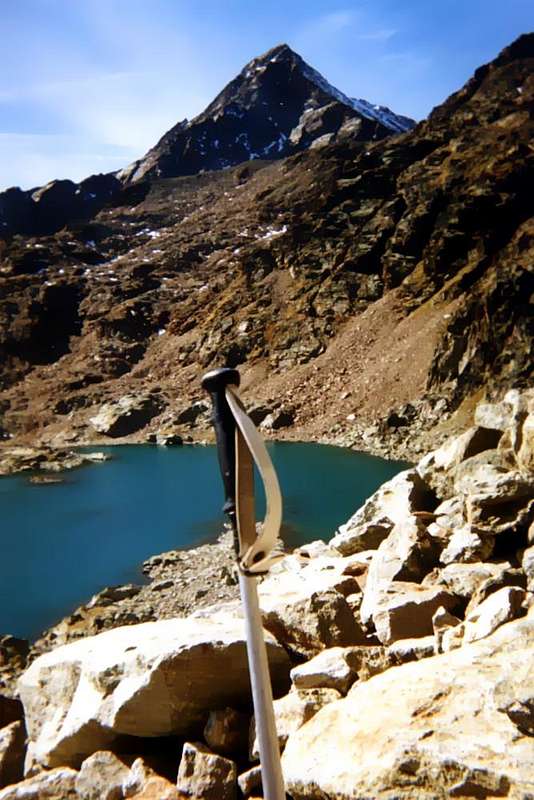

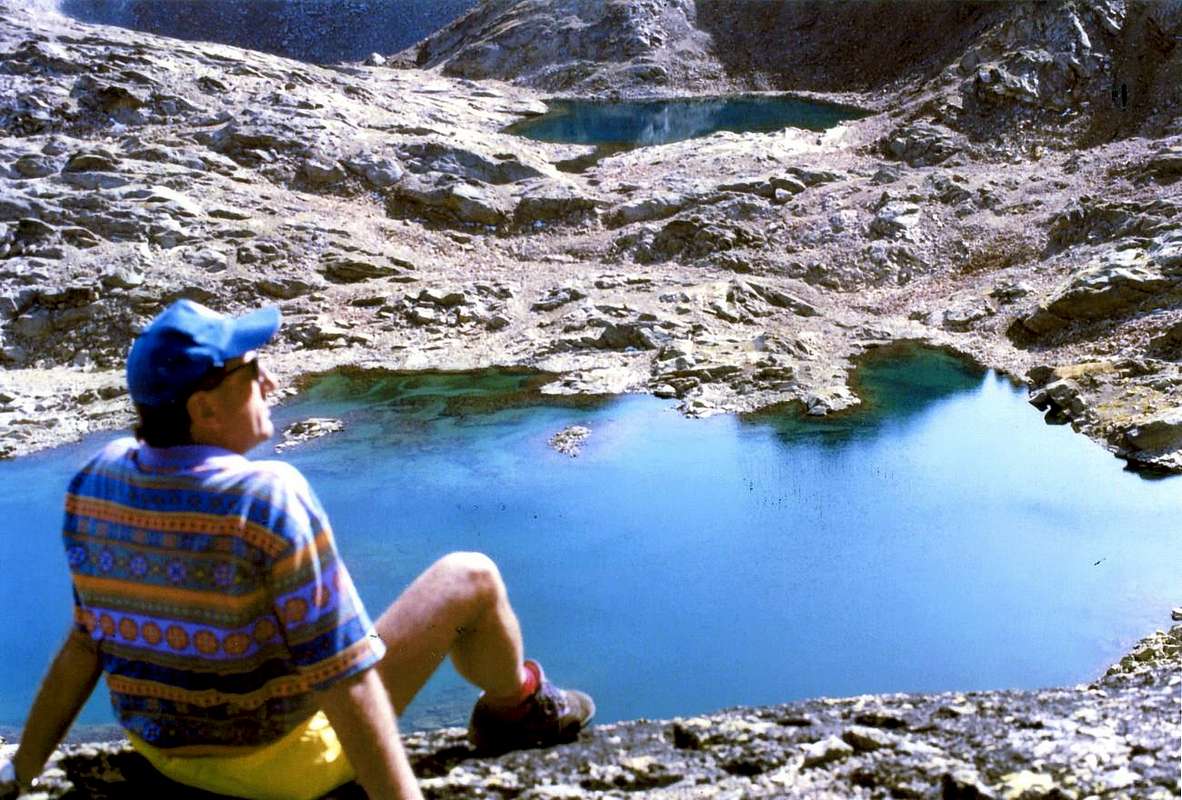
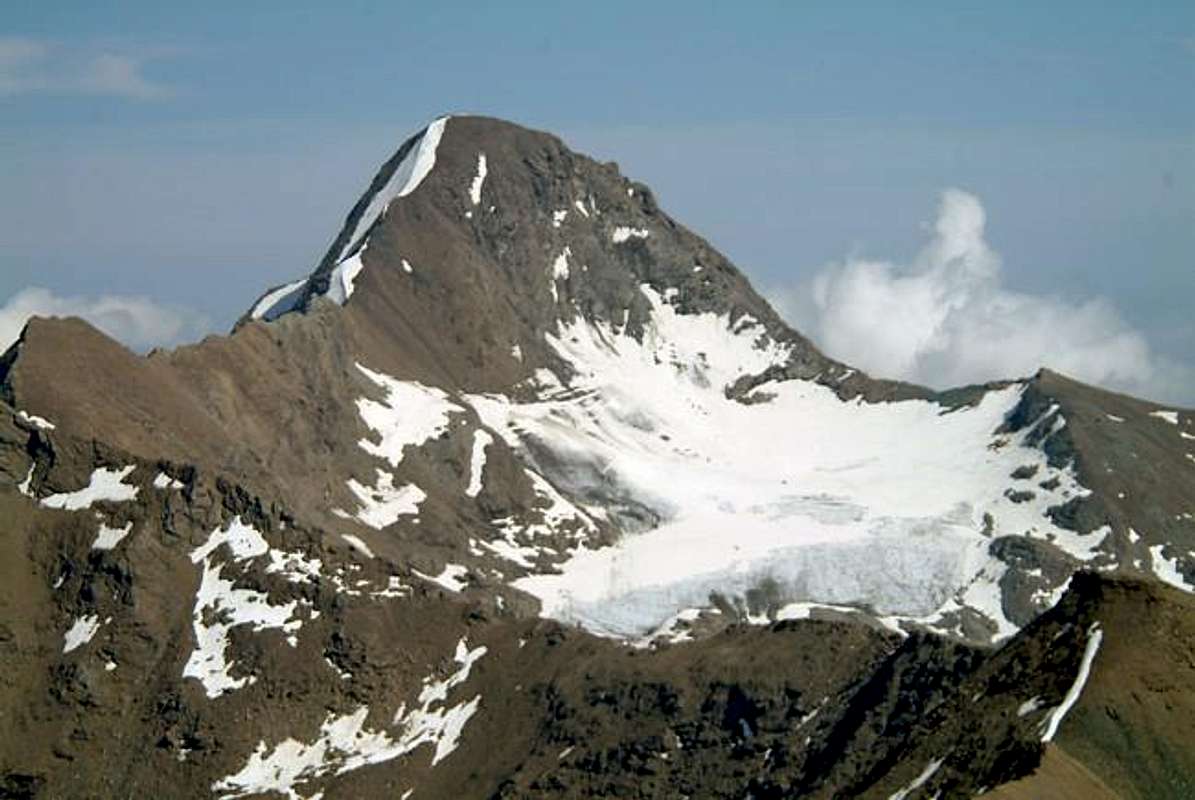
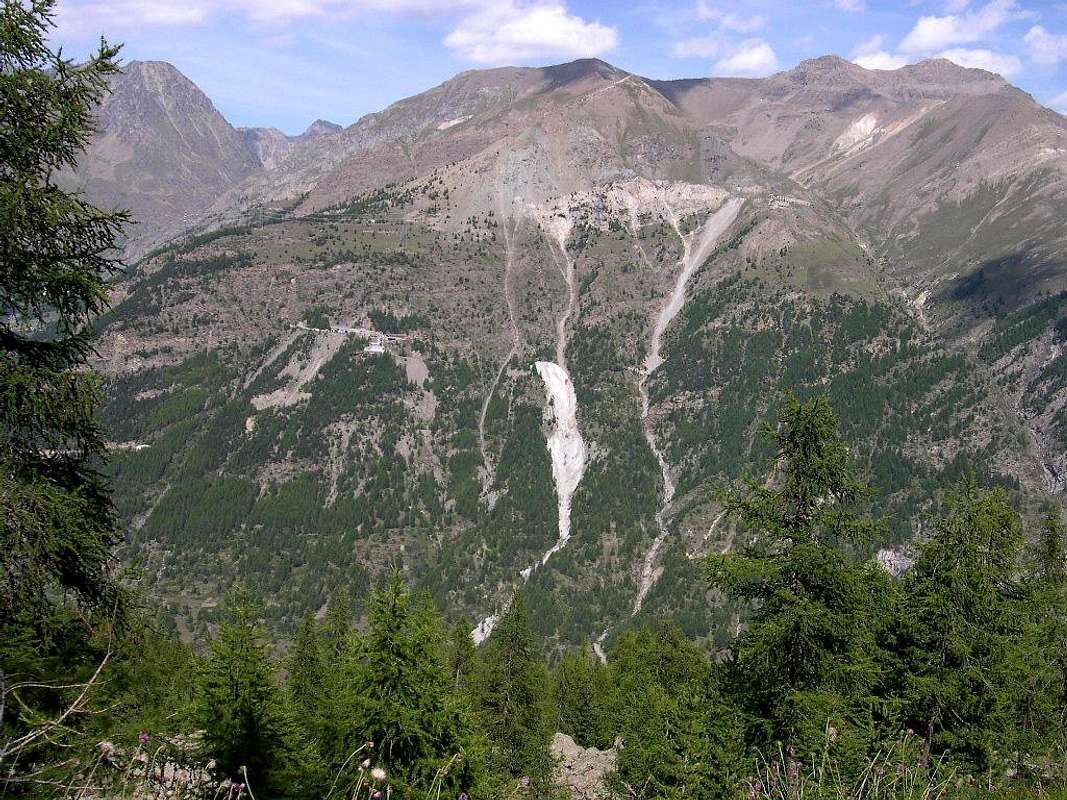
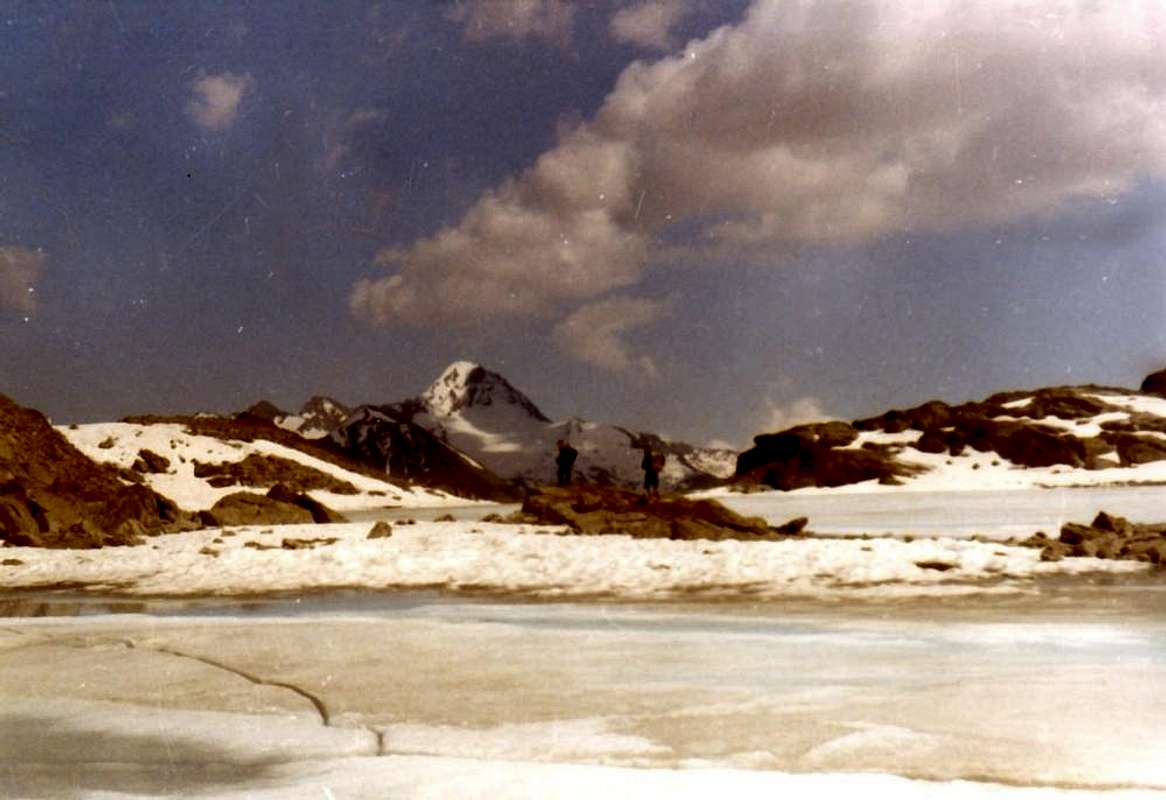
Campings
Remember that free camping is forbidden (except for emergency reasons, over 2.500m, from darkness until dawn).Mountain Condition
- Meteo: you can find all the needed informations at the official site of the Valle d'Aosta Region:
- Valle d'Aosta Meteo
Books and Maps
BOOKS:- "Guida delle Alpi Occidentali" di Giovanni Bobba e Luigi Vaccarone C.A.I. Sezione di Torino Volume II (parte II), 25 Maggio 1896.
- "Guida dei Monti d'Italia Emilius Rosa dei Banchi Parco del Mont Avic" di Giulio Berutto e Lino Fornelli - Club Alpino Italiano/Touring Club Italiano, Marzo 2005.
MAPS:
- Kompass "Gran Paradiso Valle d'Aosta Sentieri e Rifugi" Carta Turistica 1:50.000.
- Hapax "Les Sentiers Comunità Montana Monte Emilius", Luglio 2000 1:25.000.
- Enrico Editore Ivrea-Aosta "Gruppo del Gran Paradiso" 1:50.000.
- I.G.C. Torino "Carta delle Passeggiate ed Escursioni in V.D.A. Conca di Pila-Gressan" 1:20.000.
- L'Escursionista "Valle di Cogne Carta dei Sentieri" (n° 10) 1:25.000.
- L'Escursionista "Tour de la Vallée de Cogne Grand Paradis" Carta dei sentieri 1:25.000.
Important Information
- REGIONE AUTONOMA VALLE D'AOSTA the official site.
- FONDAZIONE MONTAGNA SICURA Villa Cameron, località Villard de la Palud n° 1 Courmayeur (AO) Tel: 39 0165 897602 - Fax: 39 0165 897647.
- SOCIETA' GUIDE ALPINE DI COGNE Tel. 347/9473526 – 328/1373728.
- A.I.NE.VA. (Associazione Interregionale Neve e Valanghe).
- A.IA.T. Cogne Gran Paradis via Bourgeois n° 34 Tel. 0165-74040. E-mail: aiat@cogne.org
- Ezio Sport articoli sportivi - via Bourgeois n° 64 Tel. 0165-74204.




